Tesco's Business Environment: Value Chain Model Analysis Report
VerifiedAdded on 2023/01/16
|10
|2757
|56
Report
AI Summary
This report provides a comprehensive analysis of Tesco's business environment, focusing on the application of the value chain model to understand its internal operations and strategic positioning. The report begins with an introduction to the business environment, outlining both macro and micro environmental factors. It then delves into the value chain model, explaining its components and how they contribute to competitive advantage. The core of the report analyzes Tesco's operations, including inbound and outbound logistics, operations, marketing and sales, and supportive activities such as infrastructure, procurement, technological development, and human resource management. The report examines Tesco's retail, manufacturing, and banking sectors, highlighting their strategies and challenges. A reflection section offers insights into the learning experience and the application of the value chain model in understanding organizational dynamics. Finally, the report concludes with a summary of findings and recommendations for Tesco.
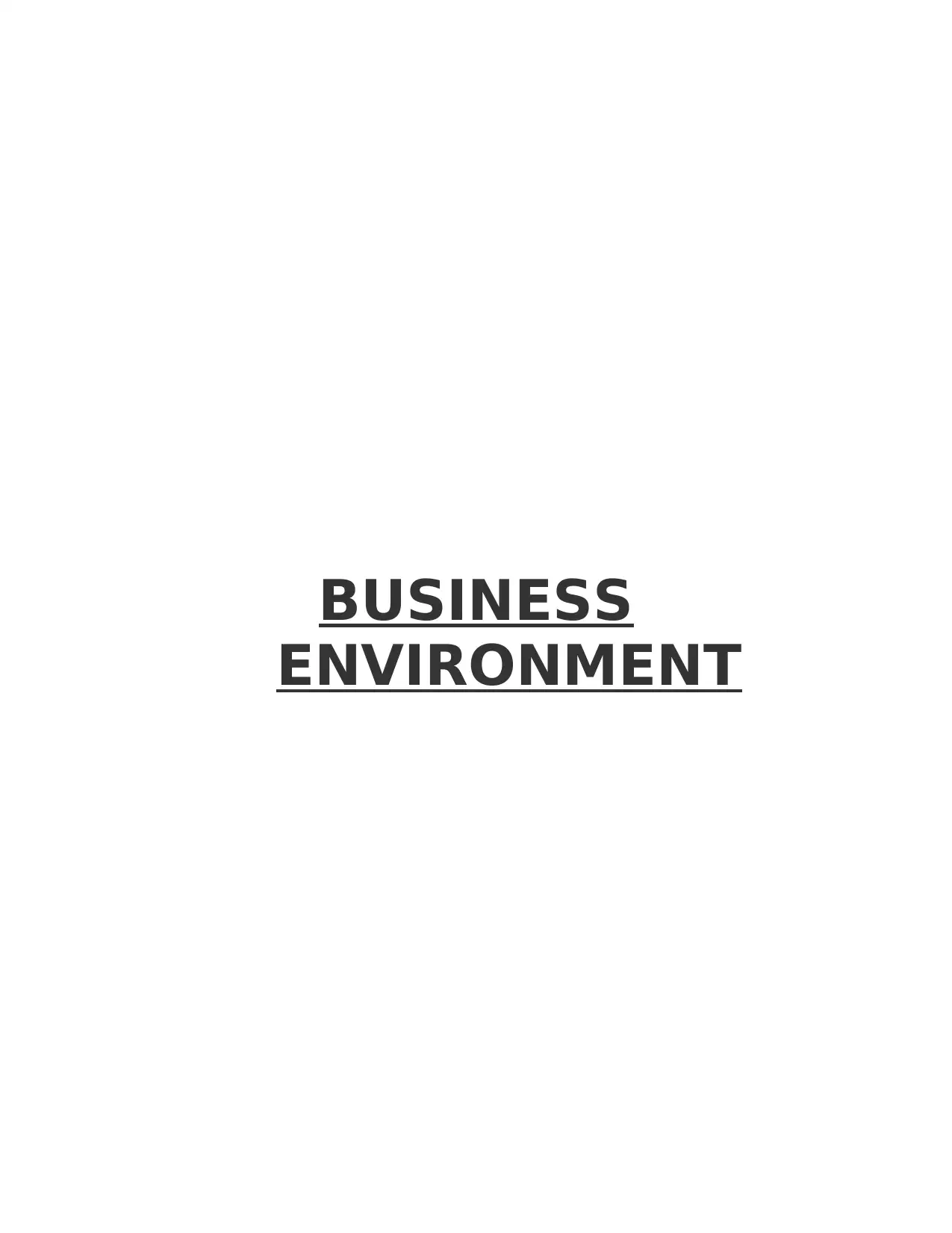
BUSINESS
ENVIRONMENT
ENVIRONMENT
Paraphrase This Document
Need a fresh take? Get an instant paraphrase of this document with our AI Paraphraser
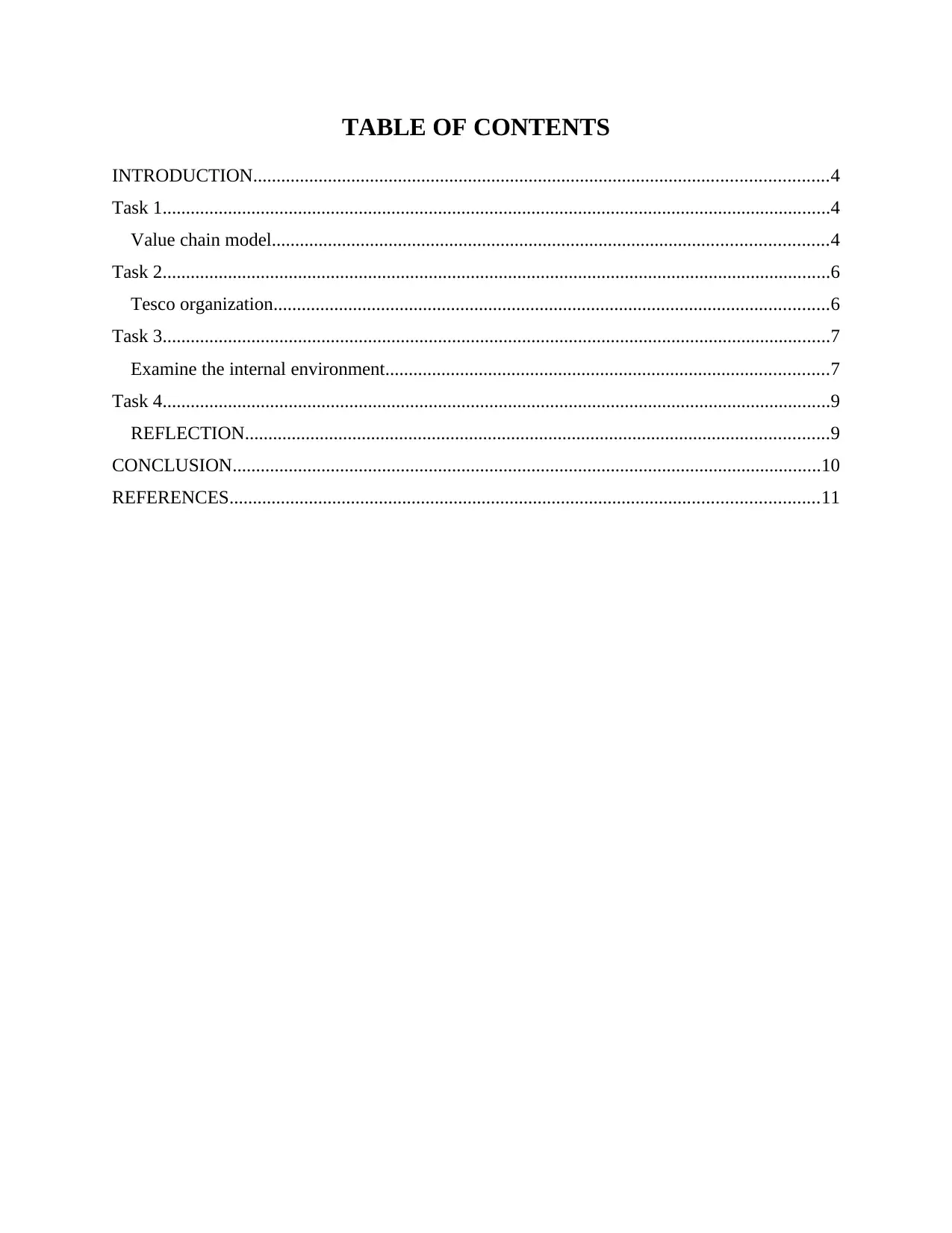
TABLE OF CONTENTS
INTRODUCTION...........................................................................................................................4
Task 1...............................................................................................................................................4
Value chain model.......................................................................................................................4
Task 2...............................................................................................................................................6
Tesco organization.......................................................................................................................6
Task 3...............................................................................................................................................7
Examine the internal environment...............................................................................................7
Task 4...............................................................................................................................................9
REFLECTION.............................................................................................................................9
CONCLUSION..............................................................................................................................10
REFERENCES..............................................................................................................................11
INTRODUCTION...........................................................................................................................4
Task 1...............................................................................................................................................4
Value chain model.......................................................................................................................4
Task 2...............................................................................................................................................6
Tesco organization.......................................................................................................................6
Task 3...............................................................................................................................................7
Examine the internal environment...............................................................................................7
Task 4...............................................................................................................................................9
REFLECTION.............................................................................................................................9
CONCLUSION..............................................................................................................................10
REFERENCES..............................................................................................................................11
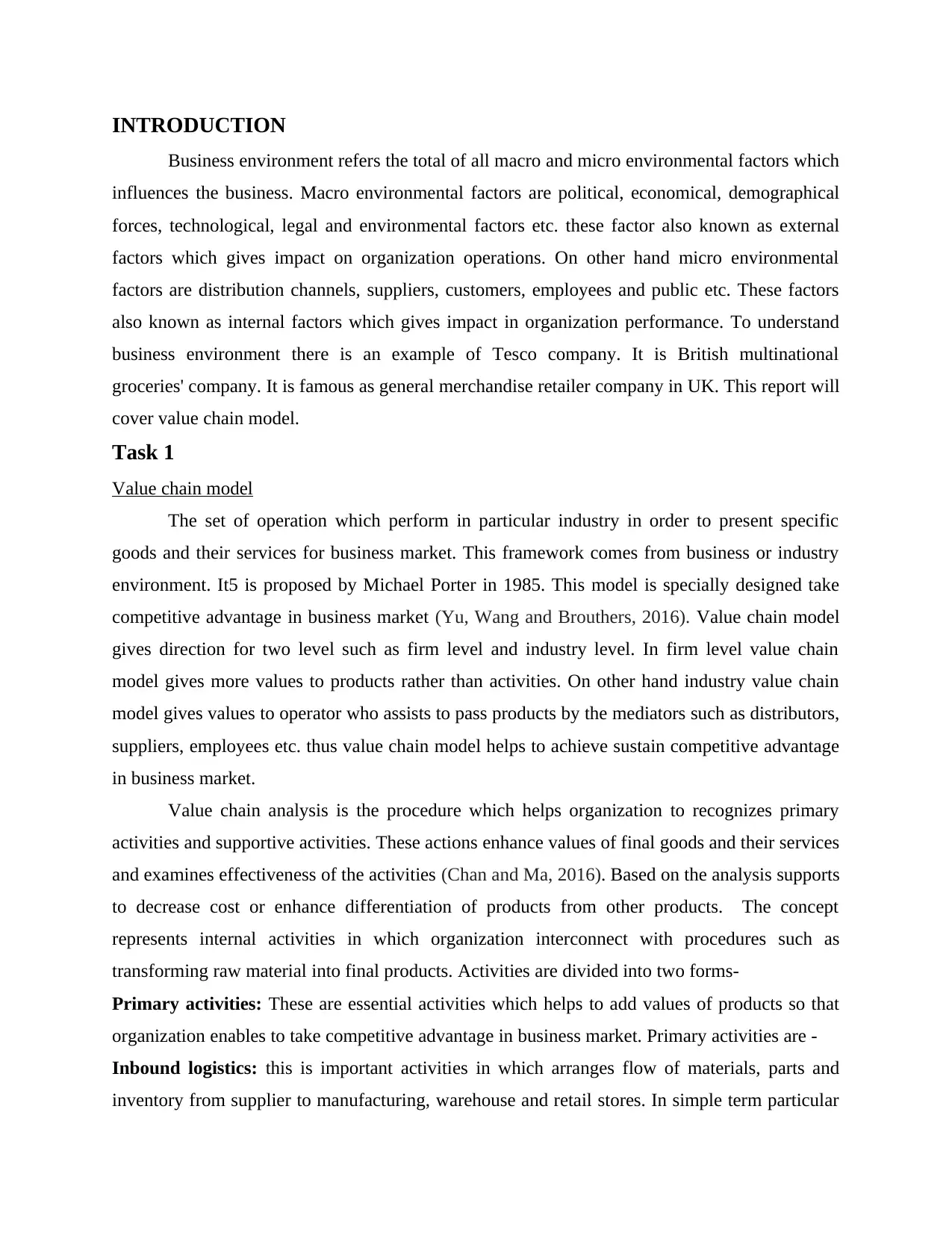
INTRODUCTION
Business environment refers the total of all macro and micro environmental factors which
influences the business. Macro environmental factors are political, economical, demographical
forces, technological, legal and environmental factors etc. these factor also known as external
factors which gives impact on organization operations. On other hand micro environmental
factors are distribution channels, suppliers, customers, employees and public etc. These factors
also known as internal factors which gives impact in organization performance. To understand
business environment there is an example of Tesco company. It is British multinational
groceries' company. It is famous as general merchandise retailer company in UK. This report will
cover value chain model.
Task 1
Value chain model
The set of operation which perform in particular industry in order to present specific
goods and their services for business market. This framework comes from business or industry
environment. It5 is proposed by Michael Porter in 1985. This model is specially designed take
competitive advantage in business market (Yu, Wang and Brouthers, 2016). Value chain model
gives direction for two level such as firm level and industry level. In firm level value chain
model gives more values to products rather than activities. On other hand industry value chain
model gives values to operator who assists to pass products by the mediators such as distributors,
suppliers, employees etc. thus value chain model helps to achieve sustain competitive advantage
in business market.
Value chain analysis is the procedure which helps organization to recognizes primary
activities and supportive activities. These actions enhance values of final goods and their services
and examines effectiveness of the activities (Chan and Ma, 2016). Based on the analysis supports
to decrease cost or enhance differentiation of products from other products. The concept
represents internal activities in which organization interconnect with procedures such as
transforming raw material into final products. Activities are divided into two forms-
Primary activities: These are essential activities which helps to add values of products so that
organization enables to take competitive advantage in business market. Primary activities are -
Inbound logistics: this is important activities in which arranges flow of materials, parts and
inventory from supplier to manufacturing, warehouse and retail stores. In simple term particular
Business environment refers the total of all macro and micro environmental factors which
influences the business. Macro environmental factors are political, economical, demographical
forces, technological, legal and environmental factors etc. these factor also known as external
factors which gives impact on organization operations. On other hand micro environmental
factors are distribution channels, suppliers, customers, employees and public etc. These factors
also known as internal factors which gives impact in organization performance. To understand
business environment there is an example of Tesco company. It is British multinational
groceries' company. It is famous as general merchandise retailer company in UK. This report will
cover value chain model.
Task 1
Value chain model
The set of operation which perform in particular industry in order to present specific
goods and their services for business market. This framework comes from business or industry
environment. It5 is proposed by Michael Porter in 1985. This model is specially designed take
competitive advantage in business market (Yu, Wang and Brouthers, 2016). Value chain model
gives direction for two level such as firm level and industry level. In firm level value chain
model gives more values to products rather than activities. On other hand industry value chain
model gives values to operator who assists to pass products by the mediators such as distributors,
suppliers, employees etc. thus value chain model helps to achieve sustain competitive advantage
in business market.
Value chain analysis is the procedure which helps organization to recognizes primary
activities and supportive activities. These actions enhance values of final goods and their services
and examines effectiveness of the activities (Chan and Ma, 2016). Based on the analysis supports
to decrease cost or enhance differentiation of products from other products. The concept
represents internal activities in which organization interconnect with procedures such as
transforming raw material into final products. Activities are divided into two forms-
Primary activities: These are essential activities which helps to add values of products so that
organization enables to take competitive advantage in business market. Primary activities are -
Inbound logistics: this is important activities in which arranges flow of materials, parts and
inventory from supplier to manufacturing, warehouse and retail stores. In simple term particular
⊘ This is a preview!⊘
Do you want full access?
Subscribe today to unlock all pages.

Trusted by 1+ million students worldwide
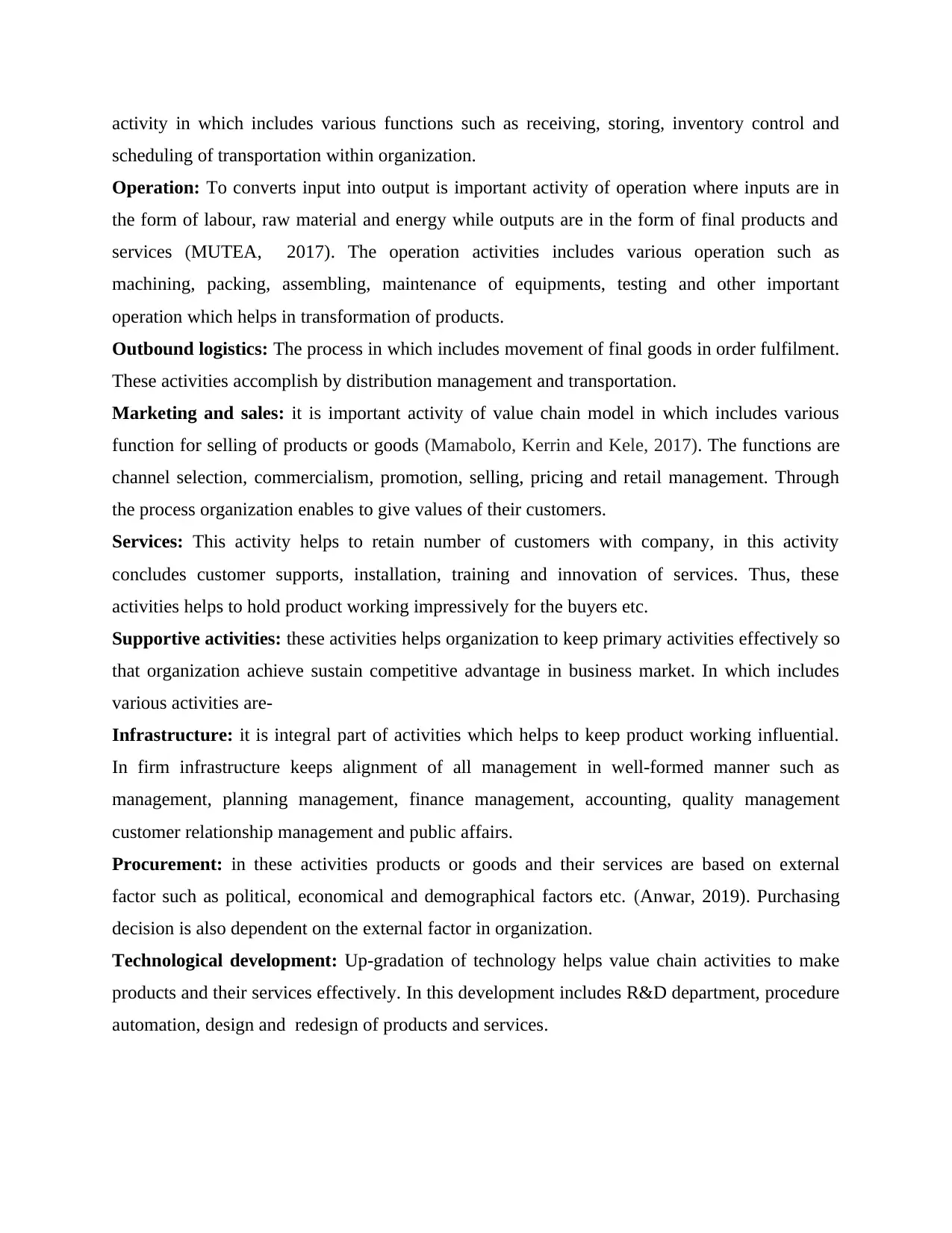
activity in which includes various functions such as receiving, storing, inventory control and
scheduling of transportation within organization.
Operation: To converts input into output is important activity of operation where inputs are in
the form of labour, raw material and energy while outputs are in the form of final products and
services (MUTEA, 2017). The operation activities includes various operation such as
machining, packing, assembling, maintenance of equipments, testing and other important
operation which helps in transformation of products.
Outbound logistics: The process in which includes movement of final goods in order fulfilment.
These activities accomplish by distribution management and transportation.
Marketing and sales: it is important activity of value chain model in which includes various
function for selling of products or goods (Mamabolo, Kerrin and Kele, 2017). The functions are
channel selection, commercialism, promotion, selling, pricing and retail management. Through
the process organization enables to give values of their customers.
Services: This activity helps to retain number of customers with company, in this activity
concludes customer supports, installation, training and innovation of services. Thus, these
activities helps to hold product working impressively for the buyers etc.
Supportive activities: these activities helps organization to keep primary activities effectively so
that organization achieve sustain competitive advantage in business market. In which includes
various activities are-
Infrastructure: it is integral part of activities which helps to keep product working influential.
In firm infrastructure keeps alignment of all management in well-formed manner such as
management, planning management, finance management, accounting, quality management
customer relationship management and public affairs.
Procurement: in these activities products or goods and their services are based on external
factor such as political, economical and demographical factors etc. (Anwar, 2019). Purchasing
decision is also dependent on the external factor in organization.
Technological development: Up-gradation of technology helps value chain activities to make
products and their services effectively. In this development includes R&D department, procedure
automation, design and redesign of products and services.
scheduling of transportation within organization.
Operation: To converts input into output is important activity of operation where inputs are in
the form of labour, raw material and energy while outputs are in the form of final products and
services (MUTEA, 2017). The operation activities includes various operation such as
machining, packing, assembling, maintenance of equipments, testing and other important
operation which helps in transformation of products.
Outbound logistics: The process in which includes movement of final goods in order fulfilment.
These activities accomplish by distribution management and transportation.
Marketing and sales: it is important activity of value chain model in which includes various
function for selling of products or goods (Mamabolo, Kerrin and Kele, 2017). The functions are
channel selection, commercialism, promotion, selling, pricing and retail management. Through
the process organization enables to give values of their customers.
Services: This activity helps to retain number of customers with company, in this activity
concludes customer supports, installation, training and innovation of services. Thus, these
activities helps to hold product working impressively for the buyers etc.
Supportive activities: these activities helps organization to keep primary activities effectively so
that organization achieve sustain competitive advantage in business market. In which includes
various activities are-
Infrastructure: it is integral part of activities which helps to keep product working influential.
In firm infrastructure keeps alignment of all management in well-formed manner such as
management, planning management, finance management, accounting, quality management
customer relationship management and public affairs.
Procurement: in these activities products or goods and their services are based on external
factor such as political, economical and demographical factors etc. (Anwar, 2019). Purchasing
decision is also dependent on the external factor in organization.
Technological development: Up-gradation of technology helps value chain activities to make
products and their services effectively. In this development includes R&D department, procedure
automation, design and redesign of products and services.
Paraphrase This Document
Need a fresh take? Get an instant paraphrase of this document with our AI Paraphraser
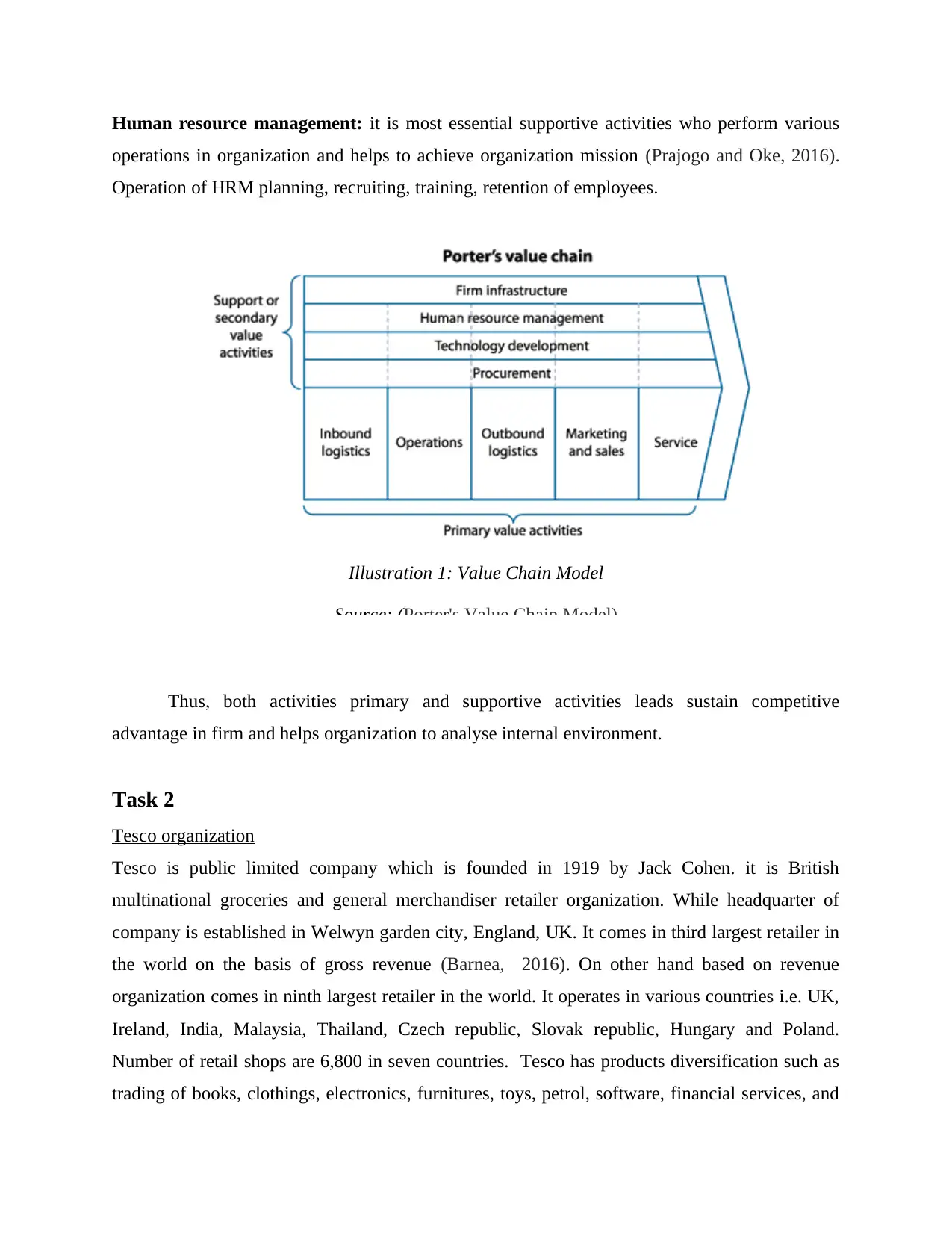
Human resource management: it is most essential supportive activities who perform various
operations in organization and helps to achieve organization mission (Prajogo and Oke, 2016).
Operation of HRM planning, recruiting, training, retention of employees.
Thus, both activities primary and supportive activities leads sustain competitive
advantage in firm and helps organization to analyse internal environment.
Task 2
Tesco organization
Tesco is public limited company which is founded in 1919 by Jack Cohen. it is British
multinational groceries and general merchandiser retailer organization. While headquarter of
company is established in Welwyn garden city, England, UK. It comes in third largest retailer in
the world on the basis of gross revenue (Barnea, 2016). On other hand based on revenue
organization comes in ninth largest retailer in the world. It operates in various countries i.e. UK,
Ireland, India, Malaysia, Thailand, Czech republic, Slovak republic, Hungary and Poland.
Number of retail shops are 6,800 in seven countries. Tesco has products diversification such as
trading of books, clothings, electronics, furnitures, toys, petrol, software, financial services, and
Illustration 1: Value Chain Model
Source: (Porter's Value Chain Model)
operations in organization and helps to achieve organization mission (Prajogo and Oke, 2016).
Operation of HRM planning, recruiting, training, retention of employees.
Thus, both activities primary and supportive activities leads sustain competitive
advantage in firm and helps organization to analyse internal environment.
Task 2
Tesco organization
Tesco is public limited company which is founded in 1919 by Jack Cohen. it is British
multinational groceries and general merchandiser retailer organization. While headquarter of
company is established in Welwyn garden city, England, UK. It comes in third largest retailer in
the world on the basis of gross revenue (Barnea, 2016). On other hand based on revenue
organization comes in ninth largest retailer in the world. It operates in various countries i.e. UK,
Ireland, India, Malaysia, Thailand, Czech republic, Slovak republic, Hungary and Poland.
Number of retail shops are 6,800 in seven countries. Tesco has products diversification such as
trading of books, clothings, electronics, furnitures, toys, petrol, software, financial services, and
Illustration 1: Value Chain Model
Source: (Porter's Value Chain Model)
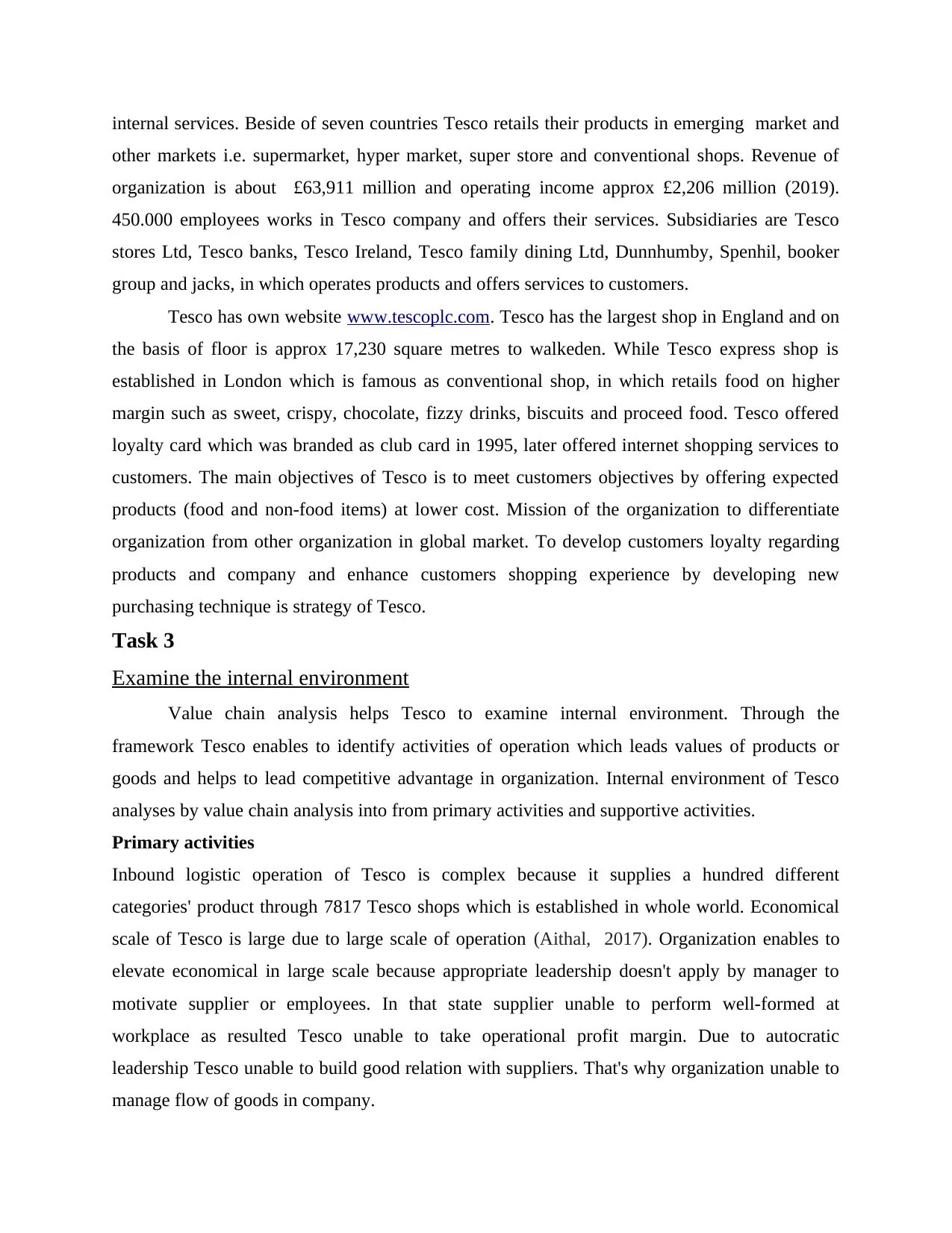
internal services. Beside of seven countries Tesco retails their products in emerging market and
other markets i.e. supermarket, hyper market, super store and conventional shops. Revenue of
organization is about £63,911 million and operating income approx £2,206 million (2019).
450.000 employees works in Tesco company and offers their services. Subsidiaries are Tesco
stores Ltd, Tesco banks, Tesco Ireland, Tesco family dining Ltd, Dunnhumby, Spenhil, booker
group and jacks, in which operates products and offers services to customers.
Tesco has own website www.tescoplc.com. Tesco has the largest shop in England and on
the basis of floor is approx 17,230 square metres to walkeden. While Tesco express shop is
established in London which is famous as conventional shop, in which retails food on higher
margin such as sweet, crispy, chocolate, fizzy drinks, biscuits and proceed food. Tesco offered
loyalty card which was branded as club card in 1995, later offered internet shopping services to
customers. The main objectives of Tesco is to meet customers objectives by offering expected
products (food and non-food items) at lower cost. Mission of the organization to differentiate
organization from other organization in global market. To develop customers loyalty regarding
products and company and enhance customers shopping experience by developing new
purchasing technique is strategy of Tesco.
Task 3
Examine the internal environment
Value chain analysis helps Tesco to examine internal environment. Through the
framework Tesco enables to identify activities of operation which leads values of products or
goods and helps to lead competitive advantage in organization. Internal environment of Tesco
analyses by value chain analysis into from primary activities and supportive activities.
Primary activities
Inbound logistic operation of Tesco is complex because it supplies a hundred different
categories' product through 7817 Tesco shops which is established in whole world. Economical
scale of Tesco is large due to large scale of operation (Aithal, 2017). Organization enables to
elevate economical in large scale because appropriate leadership doesn't apply by manager to
motivate supplier or employees. In that state supplier unable to perform well-formed at
workplace as resulted Tesco unable to take operational profit margin. Due to autocratic
leadership Tesco unable to build good relation with suppliers. That's why organization unable to
manage flow of goods in company.
other markets i.e. supermarket, hyper market, super store and conventional shops. Revenue of
organization is about £63,911 million and operating income approx £2,206 million (2019).
450.000 employees works in Tesco company and offers their services. Subsidiaries are Tesco
stores Ltd, Tesco banks, Tesco Ireland, Tesco family dining Ltd, Dunnhumby, Spenhil, booker
group and jacks, in which operates products and offers services to customers.
Tesco has own website www.tescoplc.com. Tesco has the largest shop in England and on
the basis of floor is approx 17,230 square metres to walkeden. While Tesco express shop is
established in London which is famous as conventional shop, in which retails food on higher
margin such as sweet, crispy, chocolate, fizzy drinks, biscuits and proceed food. Tesco offered
loyalty card which was branded as club card in 1995, later offered internet shopping services to
customers. The main objectives of Tesco is to meet customers objectives by offering expected
products (food and non-food items) at lower cost. Mission of the organization to differentiate
organization from other organization in global market. To develop customers loyalty regarding
products and company and enhance customers shopping experience by developing new
purchasing technique is strategy of Tesco.
Task 3
Examine the internal environment
Value chain analysis helps Tesco to examine internal environment. Through the
framework Tesco enables to identify activities of operation which leads values of products or
goods and helps to lead competitive advantage in organization. Internal environment of Tesco
analyses by value chain analysis into from primary activities and supportive activities.
Primary activities
Inbound logistic operation of Tesco is complex because it supplies a hundred different
categories' product through 7817 Tesco shops which is established in whole world. Economical
scale of Tesco is large due to large scale of operation (Aithal, 2017). Organization enables to
elevate economical in large scale because appropriate leadership doesn't apply by manager to
motivate supplier or employees. In that state supplier unable to perform well-formed at
workplace as resulted Tesco unable to take operational profit margin. Due to autocratic
leadership Tesco unable to build good relation with suppliers. That's why organization unable to
manage flow of goods in company.
⊘ This is a preview!⊘
Do you want full access?
Subscribe today to unlock all pages.

Trusted by 1+ million students worldwide
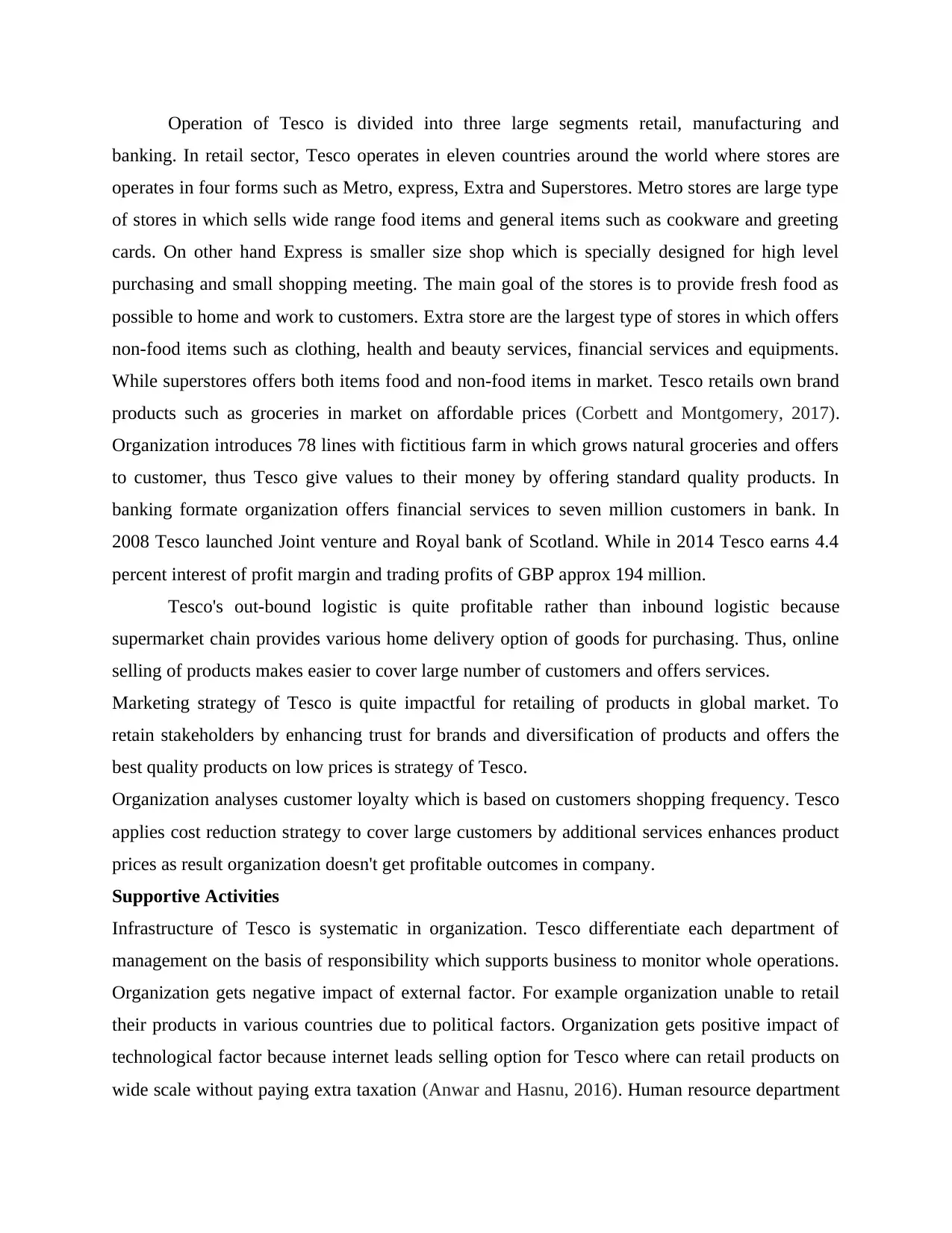
Operation of Tesco is divided into three large segments retail, manufacturing and
banking. In retail sector, Tesco operates in eleven countries around the world where stores are
operates in four forms such as Metro, express, Extra and Superstores. Metro stores are large type
of stores in which sells wide range food items and general items such as cookware and greeting
cards. On other hand Express is smaller size shop which is specially designed for high level
purchasing and small shopping meeting. The main goal of the stores is to provide fresh food as
possible to home and work to customers. Extra store are the largest type of stores in which offers
non-food items such as clothing, health and beauty services, financial services and equipments.
While superstores offers both items food and non-food items in market. Tesco retails own brand
products such as groceries in market on affordable prices (Corbett and Montgomery, 2017).
Organization introduces 78 lines with fictitious farm in which grows natural groceries and offers
to customer, thus Tesco give values to their money by offering standard quality products. In
banking formate organization offers financial services to seven million customers in bank. In
2008 Tesco launched Joint venture and Royal bank of Scotland. While in 2014 Tesco earns 4.4
percent interest of profit margin and trading profits of GBP approx 194 million.
Tesco's out-bound logistic is quite profitable rather than inbound logistic because
supermarket chain provides various home delivery option of goods for purchasing. Thus, online
selling of products makes easier to cover large number of customers and offers services.
Marketing strategy of Tesco is quite impactful for retailing of products in global market. To
retain stakeholders by enhancing trust for brands and diversification of products and offers the
best quality products on low prices is strategy of Tesco.
Organization analyses customer loyalty which is based on customers shopping frequency. Tesco
applies cost reduction strategy to cover large customers by additional services enhances product
prices as result organization doesn't get profitable outcomes in company.
Supportive Activities
Infrastructure of Tesco is systematic in organization. Tesco differentiate each department of
management on the basis of responsibility which supports business to monitor whole operations.
Organization gets negative impact of external factor. For example organization unable to retail
their products in various countries due to political factors. Organization gets positive impact of
technological factor because internet leads selling option for Tesco where can retail products on
wide scale without paying extra taxation (Anwar and Hasnu, 2016). Human resource department
banking. In retail sector, Tesco operates in eleven countries around the world where stores are
operates in four forms such as Metro, express, Extra and Superstores. Metro stores are large type
of stores in which sells wide range food items and general items such as cookware and greeting
cards. On other hand Express is smaller size shop which is specially designed for high level
purchasing and small shopping meeting. The main goal of the stores is to provide fresh food as
possible to home and work to customers. Extra store are the largest type of stores in which offers
non-food items such as clothing, health and beauty services, financial services and equipments.
While superstores offers both items food and non-food items in market. Tesco retails own brand
products such as groceries in market on affordable prices (Corbett and Montgomery, 2017).
Organization introduces 78 lines with fictitious farm in which grows natural groceries and offers
to customer, thus Tesco give values to their money by offering standard quality products. In
banking formate organization offers financial services to seven million customers in bank. In
2008 Tesco launched Joint venture and Royal bank of Scotland. While in 2014 Tesco earns 4.4
percent interest of profit margin and trading profits of GBP approx 194 million.
Tesco's out-bound logistic is quite profitable rather than inbound logistic because
supermarket chain provides various home delivery option of goods for purchasing. Thus, online
selling of products makes easier to cover large number of customers and offers services.
Marketing strategy of Tesco is quite impactful for retailing of products in global market. To
retain stakeholders by enhancing trust for brands and diversification of products and offers the
best quality products on low prices is strategy of Tesco.
Organization analyses customer loyalty which is based on customers shopping frequency. Tesco
applies cost reduction strategy to cover large customers by additional services enhances product
prices as result organization doesn't get profitable outcomes in company.
Supportive Activities
Infrastructure of Tesco is systematic in organization. Tesco differentiate each department of
management on the basis of responsibility which supports business to monitor whole operations.
Organization gets negative impact of external factor. For example organization unable to retail
their products in various countries due to political factors. Organization gets positive impact of
technological factor because internet leads selling option for Tesco where can retail products on
wide scale without paying extra taxation (Anwar and Hasnu, 2016). Human resource department
Paraphrase This Document
Need a fresh take? Get an instant paraphrase of this document with our AI Paraphraser
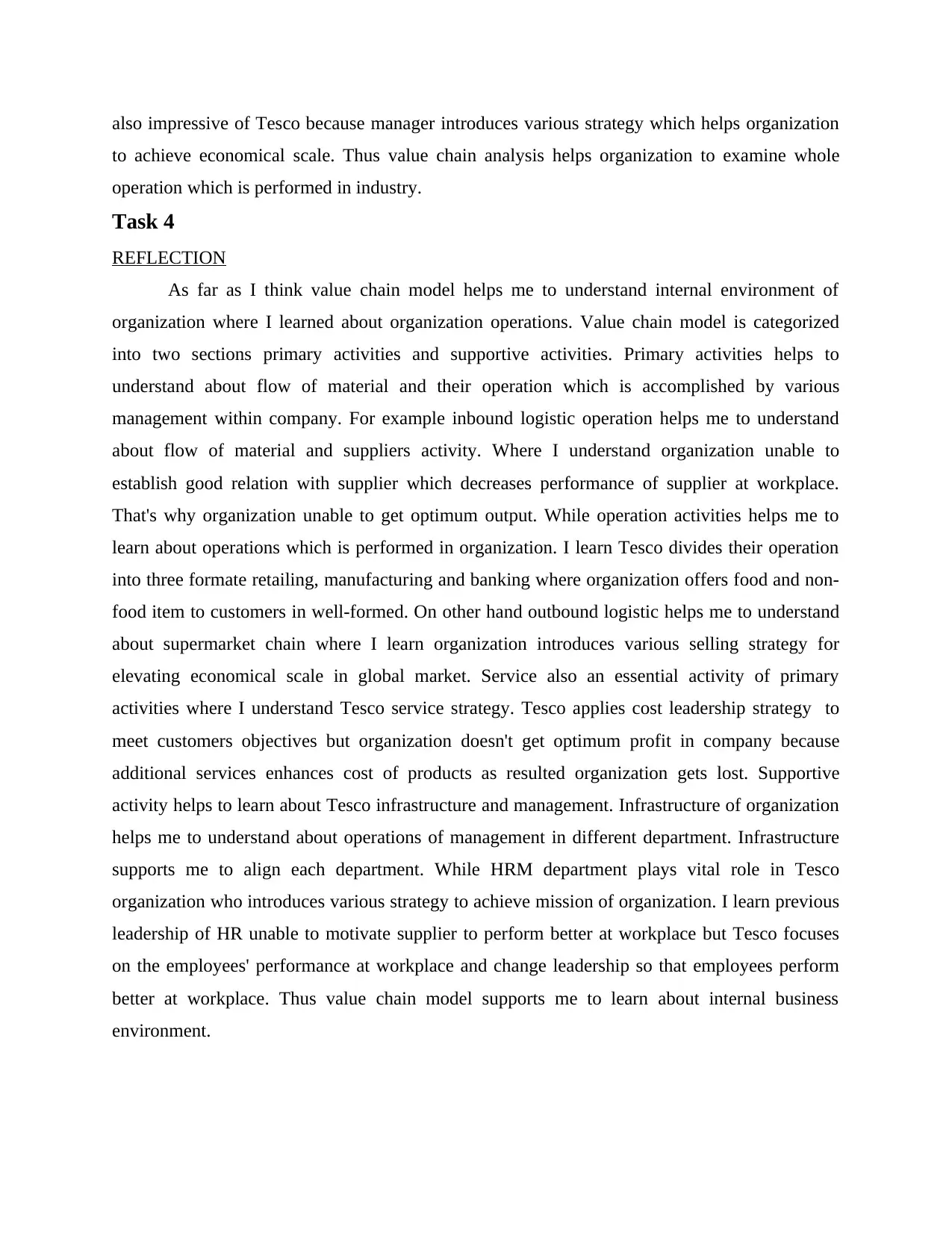
also impressive of Tesco because manager introduces various strategy which helps organization
to achieve economical scale. Thus value chain analysis helps organization to examine whole
operation which is performed in industry.
Task 4
REFLECTION
As far as I think value chain model helps me to understand internal environment of
organization where I learned about organization operations. Value chain model is categorized
into two sections primary activities and supportive activities. Primary activities helps to
understand about flow of material and their operation which is accomplished by various
management within company. For example inbound logistic operation helps me to understand
about flow of material and suppliers activity. Where I understand organization unable to
establish good relation with supplier which decreases performance of supplier at workplace.
That's why organization unable to get optimum output. While operation activities helps me to
learn about operations which is performed in organization. I learn Tesco divides their operation
into three formate retailing, manufacturing and banking where organization offers food and non-
food item to customers in well-formed. On other hand outbound logistic helps me to understand
about supermarket chain where I learn organization introduces various selling strategy for
elevating economical scale in global market. Service also an essential activity of primary
activities where I understand Tesco service strategy. Tesco applies cost leadership strategy to
meet customers objectives but organization doesn't get optimum profit in company because
additional services enhances cost of products as resulted organization gets lost. Supportive
activity helps to learn about Tesco infrastructure and management. Infrastructure of organization
helps me to understand about operations of management in different department. Infrastructure
supports me to align each department. While HRM department plays vital role in Tesco
organization who introduces various strategy to achieve mission of organization. I learn previous
leadership of HR unable to motivate supplier to perform better at workplace but Tesco focuses
on the employees' performance at workplace and change leadership so that employees perform
better at workplace. Thus value chain model supports me to learn about internal business
environment.
to achieve economical scale. Thus value chain analysis helps organization to examine whole
operation which is performed in industry.
Task 4
REFLECTION
As far as I think value chain model helps me to understand internal environment of
organization where I learned about organization operations. Value chain model is categorized
into two sections primary activities and supportive activities. Primary activities helps to
understand about flow of material and their operation which is accomplished by various
management within company. For example inbound logistic operation helps me to understand
about flow of material and suppliers activity. Where I understand organization unable to
establish good relation with supplier which decreases performance of supplier at workplace.
That's why organization unable to get optimum output. While operation activities helps me to
learn about operations which is performed in organization. I learn Tesco divides their operation
into three formate retailing, manufacturing and banking where organization offers food and non-
food item to customers in well-formed. On other hand outbound logistic helps me to understand
about supermarket chain where I learn organization introduces various selling strategy for
elevating economical scale in global market. Service also an essential activity of primary
activities where I understand Tesco service strategy. Tesco applies cost leadership strategy to
meet customers objectives but organization doesn't get optimum profit in company because
additional services enhances cost of products as resulted organization gets lost. Supportive
activity helps to learn about Tesco infrastructure and management. Infrastructure of organization
helps me to understand about operations of management in different department. Infrastructure
supports me to align each department. While HRM department plays vital role in Tesco
organization who introduces various strategy to achieve mission of organization. I learn previous
leadership of HR unable to motivate supplier to perform better at workplace but Tesco focuses
on the employees' performance at workplace and change leadership so that employees perform
better at workplace. Thus value chain model supports me to learn about internal business
environment.
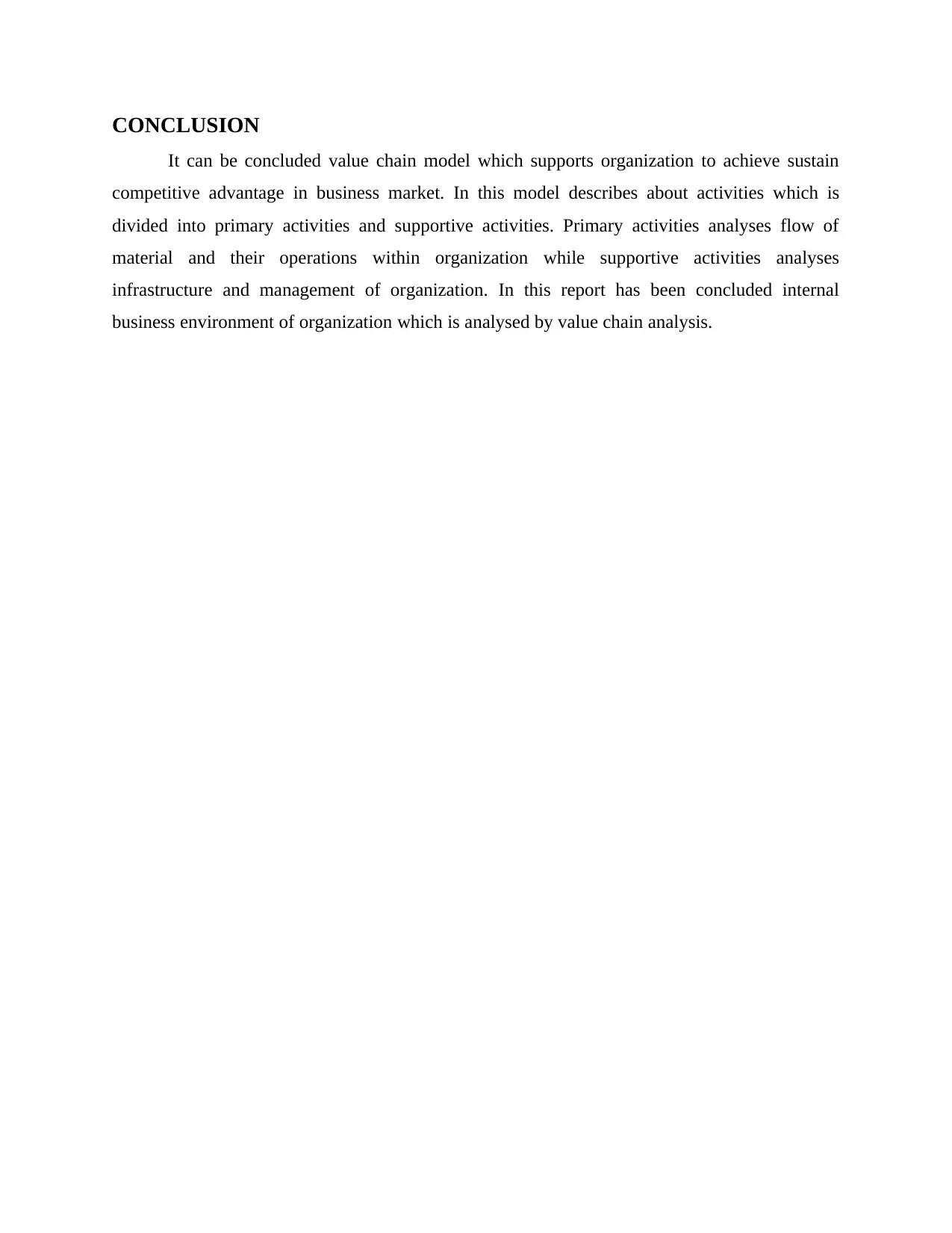
CONCLUSION
It can be concluded value chain model which supports organization to achieve sustain
competitive advantage in business market. In this model describes about activities which is
divided into primary activities and supportive activities. Primary activities analyses flow of
material and their operations within organization while supportive activities analyses
infrastructure and management of organization. In this report has been concluded internal
business environment of organization which is analysed by value chain analysis.
It can be concluded value chain model which supports organization to achieve sustain
competitive advantage in business market. In this model describes about activities which is
divided into primary activities and supportive activities. Primary activities analyses flow of
material and their operations within organization while supportive activities analyses
infrastructure and management of organization. In this report has been concluded internal
business environment of organization which is analysed by value chain analysis.
⊘ This is a preview!⊘
Do you want full access?
Subscribe today to unlock all pages.

Trusted by 1+ million students worldwide
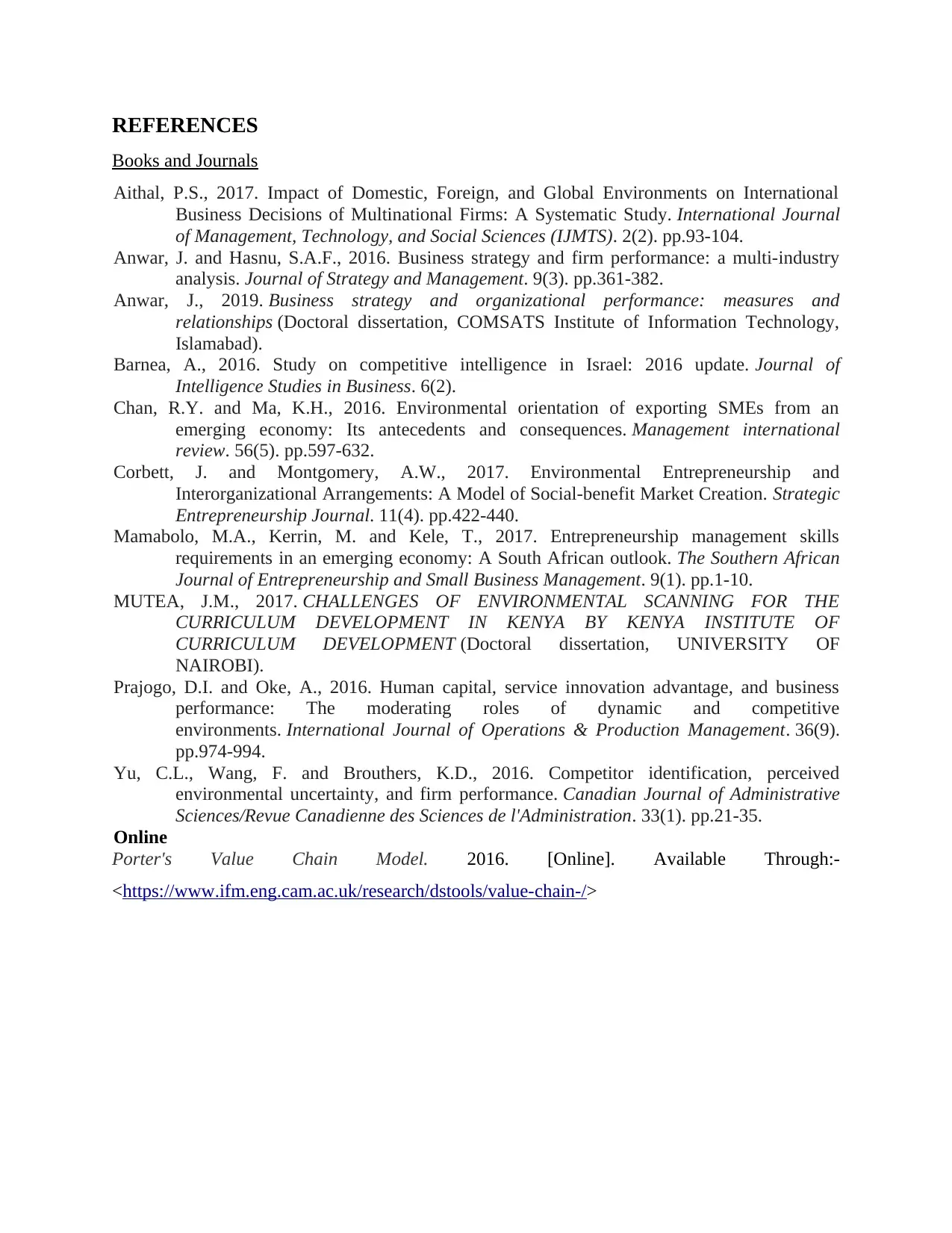
REFERENCES
Books and Journals
Aithal, P.S., 2017. Impact of Domestic, Foreign, and Global Environments on International
Business Decisions of Multinational Firms: A Systematic Study. International Journal
of Management, Technology, and Social Sciences (IJMTS). 2(2). pp.93-104.
Anwar, J. and Hasnu, S.A.F., 2016. Business strategy and firm performance: a multi-industry
analysis. Journal of Strategy and Management. 9(3). pp.361-382.
Anwar, J., 2019. Business strategy and organizational performance: measures and
relationships (Doctoral dissertation, COMSATS Institute of Information Technology,
Islamabad).
Barnea, A., 2016. Study on competitive intelligence in Israel: 2016 update. Journal of
Intelligence Studies in Business. 6(2).
Chan, R.Y. and Ma, K.H., 2016. Environmental orientation of exporting SMEs from an
emerging economy: Its antecedents and consequences. Management international
review. 56(5). pp.597-632.
Corbett, J. and Montgomery, A.W., 2017. Environmental Entrepreneurship and
Interorganizational Arrangements: A Model of Social‐benefit Market Creation. Strategic
Entrepreneurship Journal. 11(4). pp.422-440.
Mamabolo, M.A., Kerrin, M. and Kele, T., 2017. Entrepreneurship management skills
requirements in an emerging economy: A South African outlook. The Southern African
Journal of Entrepreneurship and Small Business Management. 9(1). pp.1-10.
MUTEA, J.M., 2017. CHALLENGES OF ENVIRONMENTAL SCANNING FOR THE
CURRICULUM DEVELOPMENT IN KENYA BY KENYA INSTITUTE OF
CURRICULUM DEVELOPMENT (Doctoral dissertation, UNIVERSITY OF
NAIROBI).
Prajogo, D.I. and Oke, A., 2016. Human capital, service innovation advantage, and business
performance: The moderating roles of dynamic and competitive
environments. International Journal of Operations & Production Management. 36(9).
pp.974-994.
Yu, C.L., Wang, F. and Brouthers, K.D., 2016. Competitor identification, perceived
environmental uncertainty, and firm performance. Canadian Journal of Administrative
Sciences/Revue Canadienne des Sciences de l'Administration. 33(1). pp.21-35.
Online
Porter's Value Chain Model. 2016. [Online]. Available Through:-
<https://www.ifm.eng.cam.ac.uk/research/dstools/value-chain-/>
Books and Journals
Aithal, P.S., 2017. Impact of Domestic, Foreign, and Global Environments on International
Business Decisions of Multinational Firms: A Systematic Study. International Journal
of Management, Technology, and Social Sciences (IJMTS). 2(2). pp.93-104.
Anwar, J. and Hasnu, S.A.F., 2016. Business strategy and firm performance: a multi-industry
analysis. Journal of Strategy and Management. 9(3). pp.361-382.
Anwar, J., 2019. Business strategy and organizational performance: measures and
relationships (Doctoral dissertation, COMSATS Institute of Information Technology,
Islamabad).
Barnea, A., 2016. Study on competitive intelligence in Israel: 2016 update. Journal of
Intelligence Studies in Business. 6(2).
Chan, R.Y. and Ma, K.H., 2016. Environmental orientation of exporting SMEs from an
emerging economy: Its antecedents and consequences. Management international
review. 56(5). pp.597-632.
Corbett, J. and Montgomery, A.W., 2017. Environmental Entrepreneurship and
Interorganizational Arrangements: A Model of Social‐benefit Market Creation. Strategic
Entrepreneurship Journal. 11(4). pp.422-440.
Mamabolo, M.A., Kerrin, M. and Kele, T., 2017. Entrepreneurship management skills
requirements in an emerging economy: A South African outlook. The Southern African
Journal of Entrepreneurship and Small Business Management. 9(1). pp.1-10.
MUTEA, J.M., 2017. CHALLENGES OF ENVIRONMENTAL SCANNING FOR THE
CURRICULUM DEVELOPMENT IN KENYA BY KENYA INSTITUTE OF
CURRICULUM DEVELOPMENT (Doctoral dissertation, UNIVERSITY OF
NAIROBI).
Prajogo, D.I. and Oke, A., 2016. Human capital, service innovation advantage, and business
performance: The moderating roles of dynamic and competitive
environments. International Journal of Operations & Production Management. 36(9).
pp.974-994.
Yu, C.L., Wang, F. and Brouthers, K.D., 2016. Competitor identification, perceived
environmental uncertainty, and firm performance. Canadian Journal of Administrative
Sciences/Revue Canadienne des Sciences de l'Administration. 33(1). pp.21-35.
Online
Porter's Value Chain Model. 2016. [Online]. Available Through:-
<https://www.ifm.eng.cam.ac.uk/research/dstools/value-chain-/>
1 out of 10
Related Documents
Your All-in-One AI-Powered Toolkit for Academic Success.
+13062052269
info@desklib.com
Available 24*7 on WhatsApp / Email
![[object Object]](/_next/static/media/star-bottom.7253800d.svg)
Unlock your academic potential
Copyright © 2020–2025 A2Z Services. All Rights Reserved. Developed and managed by ZUCOL.





